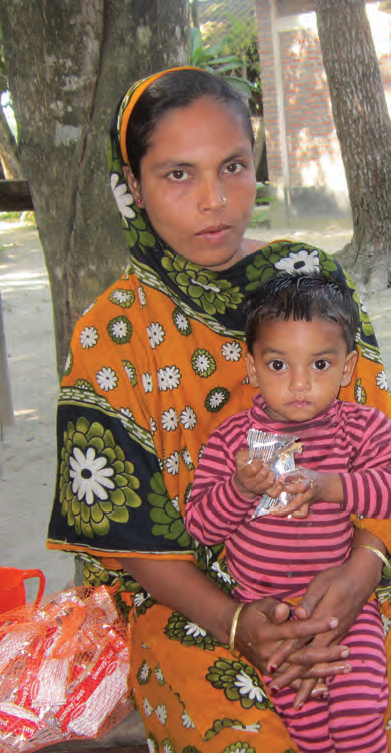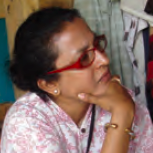Follow-up status of children with SAM treated with RUTF in peri-urban and rural Northern Bangladesh
 By Dr. Charulatha Banerjee, Monsurul Hoq and Dr. Ehsanul Matin
By Dr. Charulatha Banerjee, Monsurul Hoq and Dr. Ehsanul Matin
 Charulatha Banerjee is Regional Advisor on Maternal and Child Health & Nutrition, South Asia with the Terre des hommes Foundation (Tdh).
Charulatha Banerjee is Regional Advisor on Maternal and Child Health & Nutrition, South Asia with the Terre des hommes Foundation (Tdh).
 Monsurul Hoq was an Epidemiologist & Statistician with Tdh at the time of this study.
Monsurul Hoq was an Epidemiologist & Statistician with Tdh at the time of this study.
 Dr. Ehsanul Matin was Director of Health & Nutrition with the Bangladesh Delegation of Tdh at the time of this study.
Dr. Ehsanul Matin was Director of Health & Nutrition with the Bangladesh Delegation of Tdh at the time of this study.
The project was funded by UNICEF, Swiss Solidarity, Swiss Development Corporation and the World Food Programme. This intervention benefited from the technical guidance of Dr. Jean Pierre Papart, Tdh Health Advisor, and the support of John Brogan, Country Delegate, Tdh Bangladesh. The project was implemented by Tdh, Bangladesh Delegation.
Location: Bangladesh
What we know: Acute malnutrition in Bangladesh is highly prevalent. Treatment rollout is underway but is not yet at scale. Evidence from the Asia context of treatment outcomes in children, including post discharge, is limited.
What this article adds: An opportunistic study of outcomes of ‘cured’ children, 3 and 6 months from discharge, was conducted in an NGO supported CMAM programme in peri-urban and rural Bangladesh. Cure rate was 68%. Approximately one-third of children were lost to follow up at 3 and 6 months. At three months follow up (147 children), 9% had relapsed, 69% were moderately malnourished and the remainder had MUAC > 125mm. At 6 months follow up (112 children), only two had relapsed, 58% were moderately malnourished and 39% had MUAC > 125 mm. Referral to SFP on discharge had been delayed for the first five months of the programme. Infant and young child feeding practices were considered a significant contributing factor to acute malnutrition; a high proportion of admissions were aged 6 to 23 months.
Bangladesh is home to a large proportion of children suffering from acute malnutrition. The 2011 Demographic and Health Survey showed that 16% of children under 5 years of age were wasted, with 4% severely wasted. The Government of Bangladesh in 2011 developed Community based Management of Acute Malnutrition (CMAM) guidelines based on World Health Organisation (WHO) guidance. However, CMAM uptake has been slow, although first steps have been taken by the Government in rolling it out nationally. There is limited evidence from Asia and Bangladesh on the experience and effectiveness of CMAM and in particular, on follow-up of children who have been treated with Ready to Use Therapeutic Food (RUTF) for severe acute malnutrition (SAM) in the community.
Terre des hommes Foundation (Tdh) has been operating in the northern District of Kurigram since 1974 and currently offers comprehensive health services for women, infants and young children living in Kurigram through Government run community clinics, two maternal and child health centres and two community-based static clinics, in line with the National Nutrition Service Operational Plan and Community Clinic Project. A focus of the work has also been on Facility Based Management of SAM from a Special Nutrition Unit based on the WHO Protocol, which was adapted for use in Bangladesh in 2008. In 2011, with support from UNICEF and the World Food Programme (WFP), Tdh rolled out a CMAM intervention in Kurigram. The programme was piloted in three Unions of the District- Ghogadaha, Thanahat and Kurigram Municipality. Twelve outpatient therapeutic programme (OTP) centres covered the three unions. The centres were independent of the state system but implemented with the necessary permissions. With the Government subsequently moving to scale up CMAM rollout within the state health system, Tdh has a Memorandum of Understanding with the Ministry of Health & Family Welfare & Institute of Public Health Nutrition (IPHN) to coordinate the rollout in Kurigram district. At the time of writing, Tdh had coordinated a first round of CMAM training of all Medical Officers in the district of Kurigram as part of this rollout. The Medical Officers are heads of Primary Health care facilities in the district that will be involved in implementing CMAM.
Study overview
In order to increase our understanding of CMAM in the Asia context, a study was undertaken by Tdh in 2012 on children discharged from the programme. The retrospective cohort study took place in peri-urban and rural areas of Kurigram District of Northern Bangladesh. The objective of this opportunistic study was to report on the nutritional status of SAM children discharged as cured from a community based treatment programme. All twelve OTP centres in three unions of Kurigram District were included in the study. Children were followed up after 3 and/or 6 months, depending on the timing for the study relative to their discharge.1
Admission to the CMAM programme was based on Mid Upper Arm Circumference (MUAC) <115mm for children aged between 6 to 59 months together with a successful appetite test. The programme definition of cure is MUAC≥115mm and 15% weight gain, as per the National CMAM guideline of Bangladesh.
A total of 255 children,185 girls and 70 boys, with an average age of 14.96 months (standard deviation of ± 9.26 months) were admitted to the CMAM programme based on MUAC < 115mm, of whom 90 also had a weight-for-height z-score (WHZ) <-3. WHZ was measured for information purposes only and not used as a criterion for admission. Treatment outcomes were 68% cured (n=174), 15% defaulted (n=38) and 17% non-responders (n=42). Children were classified as non-responders when they did not achieve discharge criteria (MUAC and 15% weight gain) within three months of starting treatment with RUTF.
The follow up status of 174 children discharged as cured from the CMAM programme between January and December 2012 was assessed using service data of community based growth monitoring run by Tdh during the same period. Among 174 cured, 147 children who were discharged July – September 2012 were considered for follow up at three months, while 112 children who were discharged before July 2012 were considered for follow up at 6 months. As part of the growth monitoring service, MUAC and weight of children below five years was measured monthly. The service data was initially recorded in registers and later entered in IBM SPSS Statistics (SPSS Inc, version 19¸USA) for analysis. Data quality was ensured by a trained monitoring team who checked the measurement in the field and also validated electronic records against hard copies.
Results
A total of 147 children discharged as cured were eligible for follow up at three months, of whom 98 (66.7%) children were identified from the growth monitoring database. Thus one third of discharged children (33.3%) were lost to follow up. Of those 98 children identified, 90 children were between the ages of 6-23 months at admission to the CMAM programme. The majority of children (69%, 95% CI 60.1% -78.7%), comprising 21 boys and 47 girls, had a current MUAC status >115 and <125 mm. Only nine children (9%, 95% CI 3.4% - 15.0%) had relapsed into SAM with a MUAC < 115 mm. Twenty-one children (21.4%) were no longer acutely malnourished with a MUAC > 125 mm (95% CI 13.1% - 29.7%).
Among 112 potential follow up children who had recovered and been discharged from the programme six months earlier, a total of 71 children were successfully identified from the growth monitoring database; 65 children were in the age group of 6-23 months at admission to the CMAM programme. Thus, 36.6% were lost to follow up. Only two female children had relapsed to SAM with a MUAC<115 mms, 41 children (58%) had a MUAC status >115 and <125 mms and 28 children (39%) had a MUAC >125mms. All SAM cases were re-referred to the OTP.
Discussion
This analysis looks at nutritional status of children discharged from a CMAM programme based on their MUAC status. Although, in this sample, relapse to SAM was low at both 3 and 6 months, follow up mechanisms for those discharged from such programmes should be implemented as part of project design; Tdh now recommend three monthly follow up for the first 6 months and then at 12 months. Furthermore, the implementation of a Supplementary Feeding Programme (SFP) or any other initiative that will contribute to household food security in tandem with the therapeutic feeding programme, should also be made available. In the project area, the SFP was introduced nearly five months after the therapeutic feeding programme started which meant that children initially admitted did not get any extra nutritional support on OTP discharge. In such a situation, emphasis on appropriate complementary feeding practice based on the family pot, assuming it is adequate, becomes critical to sustain recovery.
In this study, about one third of the children were lost to follow up. After discharge from the CMAM programme, mothers were expected to bring their children for monthly growth monitoring sessions where monthly weighing and MUAC measurements were made. An important reason for not attending these sessions was migration. Families with children moved out of the intervention area for various reasons – entire family migrating looking for better working opportunities or to look for better accommodation. Mothers visiting relatives or a pregnant mother moving to her parental home for delivery were also reasons for not attending. Women who had no support at home to look after other children or women who were daily wage earners themselves were unable to continue attending the programme. On exploring this further with mothers, it was determined that the mother did not feel routine measurement was important and was only concerned if the child fell ill again. A few women with extended family support also could not attend due to the family, often elderly family members, prohibiting them from attending.
In this pilot programme, non-response 2 and defaulting3 rates did not meet Sphere standards. Default and non-responder rates were higher in the 24-59 months age group compared to the 6-23 month group (p < 0.05). There was no gender difference in defaulter or non-responder rates. An important reason for defaulting was migration for the same reasons as children who were lost to follow up (see above). Most of these missed visits once the child showed some recovery in the mother’s eyes; she did not then see the importance of completing the treatment. Domestic disputes and elderly family members not allowing the mother to attend the OTP were also given as reasons. An important reason for non-response to treatment was poor complementary feeding, including breastfeeding. Children who did not gain weight, in households which could afford a nutritious meal for the child, seemed to rely entirely on RUTF to feed the child for the duration of treatment. A small number of cases of sharing were also reported, while a few households had a real shortage of food for the entire family. Not seeking treatment for illnesses and repeated illnesses also contributed to non-response.
In the Tdh programme’s experience, lack of knowledge regarding infant and young child feeding (IYCF) practices were an important contributing factor to child malnutrition in Kurigram District, e.g. delayed introduction of high quality protein foods such as fish, even where there was adequate household access and daily consumption amongst older household members. Tdh are of the view that CMAM interventions often underemphasise the importance of IYCF. The immediate need after recovery from acute malnutrition is to ensure the quickest return for a child to consumption of normal household meal composition and frequency as per IYCF guidelines. This is the only sustainable solution to preserve the child’s recovered status and give mothers the confidence that they have the resources to nourish and nurture their children. However, this principle only works where there is no food insecurity.
Tdh, as part of its comprehensive approach to prevention and treatment of acute malnutrition, has since introduced follow up of all children discharged from the therapeutic feeding programme for a period of six months through home visits by field workers. The organisation has also stepped up its behaviour change communication programme on IYCF. During monthly growth monitoring days in the community, Tdh holds cooking sessions using locally available and affordable foods to demonstrate to mothers what can be achieved with their own resources. Additionally, an intensive homestead gardening programme was started in the area and mothers with children under 5 years are especially encouraged to get involved. As it has been rolled out, it has developed to specifically include families with MAM or SAM children.
Including follow up of discharged children through community groups and house to house visits, as currently takes place for post-natal visits, would be valuable. We suggest that routine MUAC measurement at quarterly intervals becoming a mandatory part of the CMAM programme extension work; this is now being implemented in Kurigam District.
Bangladesh has now rolled out the National Nutrition Service and through this, it is expected that CMAM roll out will be implemented in a phased manner and incorporated into the activities of the Community Clinic, with the CHCP (Community Health Clinic Promoter) being the frontline worker. In this context, the usefulness of MUAC for detection of acute malnutrition and follow up is clearly critical. Follow up will also be useful to detect any seasonal fluctuations, which may be particularly significant in areas prone to extreme climatic events such as floods, cyclones and severe cold winter periods.
For more information, contact: Dr Charulatha Banerjee, email: charulatha.banerjee@tdh.ch
1Three month follow up was assessed in all children for whom there were available data, and in a subset of 112 children from whom there were six month data. The study examined the very small number of children who were present in both datasets; this added no additional information and so is not presented here.
2As per the national guidelines, a non-responder is one who does not attain the discharge criteria within three months of admission into the CMAM programme.
3As per the national guidelines, a defaulter is a case who before attaining discharge criteria is absent from the programme for three consecutive weeks.


